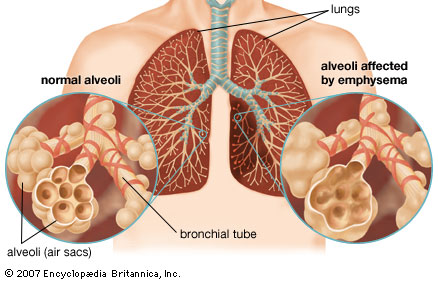
What is lung cancer?
Lung cancer is cancer that usually starts in the lining of the bronchi (the main airways of the lungs), but can also begin in other areas of the respiratory system, including the trachea, bronchioles, or alveoli. It is the leading cause of cancer death in both men and women. In 2008, 215,020 new cases of lung cancer are expected, according to the American Cancer Society.
Lung cancers are believed to develop over a period of many years.
Nearly all lung cancers are carcinomas, a cancer that begins in the lining or covering tissues of an organ. the tumor cells of each type of lung cancer grow and spread differently, and each type requires different treatment. about 85 percent to 90 percent of lung cancers belong to the group called non-small cell lung cancer.
Lung cancers are generally divided into two types:
- Nonsmall cell lung cancer is much more common than small cell lung cancer. the three main kinds of nonsmall cell lung cancer are named for the type of cells in the tumor:
- Squamous cell carcinoma, also called epidermoid carcinoma, is the most common type of lung cancer in men. It often begins in the bronchi and usually does not spread as quickly as other types of lung cancer.
- Adenocarcinoma usually begins along the outer edges of the lungs and under the lining of the bronchi. It is the most common type of lung cancer in people who have never smoked.
- Large cell carcinomas are a group of cancers with large, abnormal-looking cells. these tumors usually begin along the outer edges of the lungs.
- Small cell lung cancer, sometimes called oat cell cancer because the cancer cells may look like oats when viewed under a microscope, grows rapidly and quickly spreads to other organs. There are two stages of small cell lung cancer:
- limited - cancer is generally found only in one lung. There may also be cancer in nearby lymph nodes on the same side of the chest.
- extensive - cancer has spread beyond the primary tumor in the lung into other parts of the body.
It is important to find out what kind of lung cancer a person has. the different types of carcinomas, involving different regions of the lung, may cause different symptoms and are treated differently.
What are the symptoms of lung cancer?
The following are the most common symptoms for lung cancer. however, each individual may experience symptoms differently.
Lung cancer usually does not cause symptoms when it first develops, but they often become present after the tumor begins growing. a cough is the most common symptom of lung cancer. other symptoms include:
- constant chest pain
- shortness of breath
- wheezing
- recurring lung infections, such as pneumonia or bronchitis
- bloody or rust-colored sputum
- hoarseness
- a tumor that presses on large blood vessels near the lung can cause swelling of the neck and face
- a tumor that presses on certain nerves near the lung causing pain and weakness in the shoulder, arm, or hand
- fever for unknown reason
Like all cancers, lung cancer can cause:
- fatigue
- loss of appetite
- loss of weight
- headache
- pain in other parts of the body not affected by the cancer
- bone fractures
Other symptoms can be caused by substances made by lung cancer cells–referred to as a paraneoplastic syndrome. Certain lung cancer cells produce a substance that causes a sharp drop in the level of sodium in the blood, which can cause many symptoms, including confusion and sometimes even coma.
None of these symptoms is a sure sign of lung cancer. Only a physician can tell whether a patient’s symptoms are caused by cancer or by another problem. Consult your physician for a diagnosis.
What are the risk factors for lung cancer?
A risk factor is anything that increases a person’s chance of getting a disease such as cancer. different cancers have different risk factors. several risk factors make a person more likely to develop lung cancer:
- Smoking is the leading cause of lung cancer, with nearly 90 percent of lung cancers thought to be a result of smoking.
Additional risk factors include:
- secondhand smoke – breathing in the smoke of others
- smoking marijuana cigarettes, which:
- contain more tar than tobacco cigarettes.
- are inhaled very deeply.
- are smoked all the way to the end where tar content is the highest.
Because marijuana is an illegal substance, it is not possible to control whether it contains fungi, pesticides, and other additives.
For more information on lung cancer or to find out more about El Camino Hospital’s current clinical trials, give us a call at (800) 216-5556